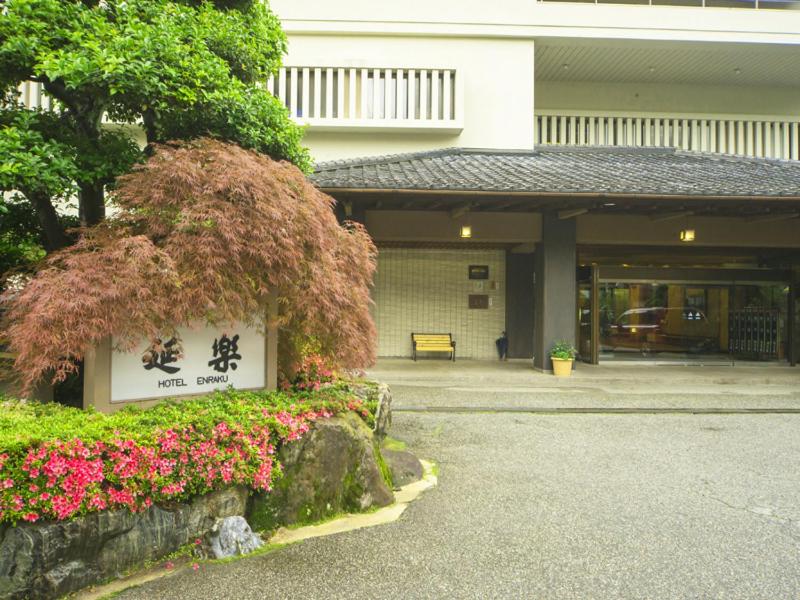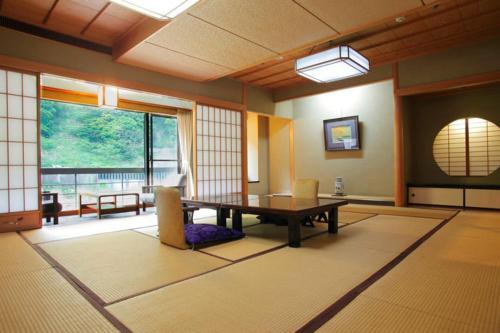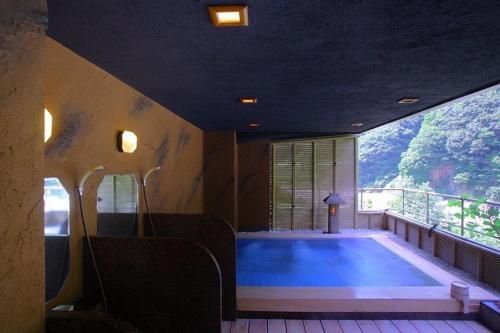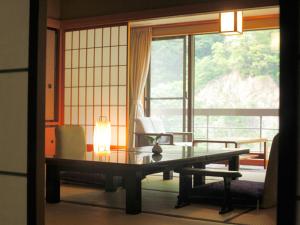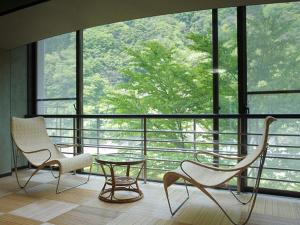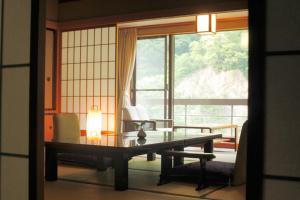Enraku
938-0382 Toyama, Kurobe, Unazuki-Onsen 347-1, Japan – Great location - show map – Railway access
A 7-minute walk from beautiful Kurobe Gorge, Enraku offers Japanese-style rooms with Kurobe River views. It features hot spring baths, a beauty salon and a charged sauna. The lobby provides free Wi-Fi, and seasonal local cuisine is served in the room. Enraku’s 5 different hot springs and hot public baths include open-air baths, a bath with river views and a 24-hour bath. Guests can play table tennis, while a souvenir shop, a bar and drinks vending machines are on-site. Tranquil rooms feature a tatami (woven-straw) floor and sliding shoji paper screens that open to a seating area with chairs and a table, at floor-to-ceiling windows. Guests sleep in traditional futon bedding. Enraku serves a delicious Japanese breakfast and a traditional multi-course dinner featuring local seafood. Meals are served in the room, where guests can enjoy them with river views. Enraku offers a free shuttle service to/from Unazuki-Onsen Train Station, a 3-minute walk away. Amusement park Mirage Land is a 40-minute drive from the hotel.
Couples particularly like the location — they rated it 8.6 for a two-person trip.
Distance in property description is calculated using © OpenStreetMap
- Free parking
- Family rooms
- Bar
- Breakfast
Categories:
Guests who stayed here loved
 Serene
Serene Singapore“very clean and beautiful, dinner and breakfast were elaborate and tasty!”
Singapore“very clean and beautiful, dinner and breakfast were elaborate and tasty!” Noriko
Noriko Japan“部屋から見えるロケーションが良かった。 氷見牛のしゃぶしゃぶとノドグロの焼き物ふがおいしかった。 3Fの檜のお風呂が気持ち良かった。”
Japan“部屋から見えるロケーションが良かった。 氷見牛のしゃぶしゃぶとノドグロの焼き物ふがおいしかった。 3Fの檜のお風呂が気持ち良かった。”
Property surroundings
Facilities of EnrakuGreat facilities! Review score, 8
- Free parking
- Family rooms
- Bar
- Breakfast
- Slippers
- Private bathroom
- Toilet
- Free toiletries
- Bath
- Shower
- Refrigerator
- Tatami (traditional Japanese flooring)
- Table tennisAdditional charge
- Seating Area
- Desk
- Telephone
- TV
- Bar
- Shuttle service
- Vending machine (drinks)
- Luggage storage
- Meeting/banquet facilitiesAdditional charge
- Air conditioning
- Heating
- Lift
- Family rooms
- Public Bath
- Open-air bath
- Hot spring bath
- MassageAdditional charge
- SaunaAdditional charge
- English
- Japanese
House rulesEnraku takes special requests - add in the next step!
Child policies
Children of any age are welcome.
To see correct prices and occupancy information, please add the number of children in your group and their ages to your search.
Cot and extra bed policies
Cots and extra beds are not available at this property.







The fine printNeed-to-know information for guests at this property
Guests with a tattoo may not be permitted to enter public bathing areas and other public facilities.
To use the property's free shuttle, please make a reservation at time of booking, or call upon arrival at the station. The hotel's contact information can be found in the booking confirmation.
FAQs about Enraku
-
Yes, Enraku is popular with guests booking family stays.
-
Room options at Enraku include:
- Family
- Quadruple
-
Check-in at Enraku is from 15:00, and check-out is until 10:00.
-
Enraku is 8.1 miles from the centre of Kurobe. All distances are measured in straight lines. Actual travel distances may vary.
-
The prices at Enraku may vary depending on your stay (e.g. dates you select, hotel's policy etc.). See the prices by entering your dates.
-
Enraku offers the following activities / services (charges may apply):
- Sauna
- Massage
- Table tennis
- Open-air bath
- Hot spring bath
- Public Bath
